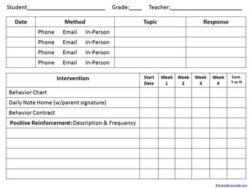Embarking on a journey to improve your health is a fantastic step, but let’s be honest, sticking to new habits can feel like climbing a mountain. Whether it’s eating healthier, exercising more, getting better sleep, or managing stress, our best intentions often face challenges from busy schedules, old routines, and the sheer effort required to make a lasting change. It’s easy to get discouraged when progress feels slow or when you slip up along the way.
That’s where a structured approach can make all the difference. Imagine having a clear, written agreement with yourself and perhaps a trusted supporter, outlining your health goals, the steps you’ll take, and even the rewards for your hard work. This isn’t just a wish list; it’s a powerful tool for commitment and accountability. A well-designed health behavior change contract template can transform abstract aspirations into concrete actions, significantly increasing your chances of success.
Why a Contract? The Power of Commitment
At its heart, a contract serves as a formal declaration of intent. When you put your health goals down on paper and sign it, you’re not just making a mental note; you’re creating a psychological anchor. This act of formalizing your commitment can be incredibly motivating, helping you stay on track even when motivation wanes. It transforms your health journey from a vague aspiration into a serious project with defined parameters, making it easier to measure progress and hold yourself accountable. It acts as a constant reminder of what you set out to achieve and why it’s important to you.
Beyond the psychological boost, a good contract provides a clear roadmap. It forces you to think through the specifics of your desired change, rather than just vaguely wishing for a better outcome. This detailed planning helps anticipate potential obstacles and strategize solutions before they arise. It moves you from “I want to exercise more” to “I will walk 30 minutes, 4 times a week, on Monday, Wednesday, Friday, and Saturday mornings.” This level of detail is crucial for turning intentions into consistent actions.
Key Elements to Include
- Specific Goals: Clearly define what you want to achieve. Make it SMART – Specific, Measurable, Achievable, Relevant, and Time-bound.
- Action Plan: Outline the exact steps you will take to reach your goal, including frequency, duration, and specific activities.
- Timeline: Set a start date and a target completion date, along with smaller milestones to celebrate along the way.
- Rewards: Identify positive reinforcements you’ll give yourself for reaching milestones or the ultimate goal.
- Consequences: Consider gentle, self-imposed consequences if you don’t meet your commitments, not as punishment, but as a motivator to refocus.
- Support Person(s): Name someone who will help hold you accountable, offer encouragement, and perhaps even sign the contract with you.
- Signature(s): Sign the contract yourself, and ideally, have your support person sign it too, solidifying the agreement.
SMART goals are the backbone of any effective health behavior change contract template. For instance, instead of “eat better,” a SMART goal might be “consume at least 5 servings of vegetables daily for the next 30 days.” This makes it clear what success looks like and provides a benchmark for tracking. Breaking down larger goals into smaller, manageable steps within your action plan also makes the overall objective feel less daunting and more achievable, fostering a sense of continuous accomplishment.
The inclusion of rewards and consequences is not about bribery or punishment, but about leveraging behavioral psychology to reinforce positive actions. A reward could be something simple like buying a new book after consistently exercising for a month, while a consequence might involve donating a small amount to a charity you don’t particularly support if you miss a certain number of workouts. These mechanisms create additional incentives and help build momentum towards your health aspirations, making the journey more engaging.
Finally, involving a support person or “accountability buddy” adds an external layer of commitment. Knowing that someone else is aware of your goals and is tracking your progress can provide that extra push on days when your internal motivation might be low. This shared commitment strengthens your resolve and provides a valuable source of encouragement and understanding, making your health journey a collaborative effort rather than a solitary struggle.
Crafting Your Own Health Behavior Change Contract Template
Designing your own contract might seem like a lot of work, but it’s actually a straightforward process that empowers you to take control of your health. Start by identifying the single most important health behavior you want to change or adopt right now. Don’t try to tackle everything at once. Focus on one specific area, whether it’s increasing water intake, reducing screen time, or incorporating a new form of physical activity. Clarity on your primary target is the first step towards an effective contract.
Once you have your core behavior in mind, begin to detail each section of your contract. Think about the specific actions you’ll take, the frequency, and the intensity. For example, if your goal is to reduce sugar intake, your actions might involve “no added sugars in coffee” or “avoiding sugary drinks entirely.” Be as precise as possible, as this removes ambiguity and makes it easier to track your progress and avoid excuses.
Consider these steps when filling out your template:
- Identify Your Goal: What specific health behavior are you committed to changing?
- Detail Your Actions: What specific steps will you take daily or weekly to achieve this goal?
- Set Your Timeline: What is your start date, and when do you expect to reach your initial milestone or ultimate goal?
- Determine Rewards & Consequences: What positive reinforcement will motivate you, and what gentle consequence will prompt you back on track?
- Enlist Support: Who will be your accountability partner, and what role will they play?
- Sign It!: Make it official by signing and dating your contract.
It’s also crucial to anticipate potential roadblocks. What usually prevents you from sticking to your health goals? Is it lack of time, stress, or cravings? Incorporate strategies into your contract to address these challenges proactively. For instance, if lack of time is an issue, schedule your workouts into your calendar like any other important appointment. Having a plan for these common pitfalls will make your contract more robust and adaptable.
Remember, a health behavior change contract template isn’t set in stone. It’s a living document that you can review and adjust as you learn more about what works for you and as your circumstances change. Life happens, and flexibility is key. If a particular reward isn’t motivating you, change it. If a goal seems too ambitious, break it down further. The goal is to support your journey towards better health, and the contract should always serve that purpose effectively.
Taking concrete steps toward improving your health is an investment in your well-being, and a structured approach significantly increases the likelihood of success. By formalizing your intentions and outlining your path with a clear plan, you are setting yourself up for positive, lasting change. This proactive method allows you to move beyond fleeting resolutions and embrace a committed, actionable strategy for achieving your health aspirations.
So, take a moment to reflect on the health changes you wish to see in your life. By leveraging the power of a written commitment, you’re not just hoping for change; you’re actively creating it. Empower yourself with this practical tool, and watch as your consistent efforts transform into sustainable, healthier habits that will benefit you for years to come.



